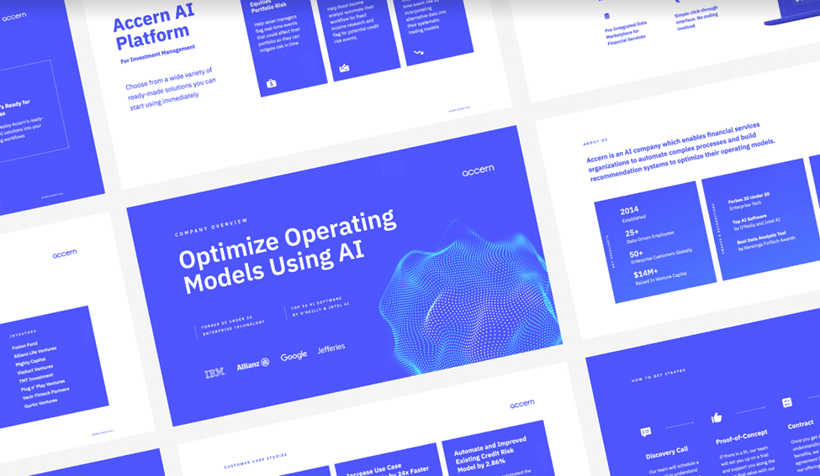- Solutions
-
Products
-
Resources
Sales Automation: What It Is, How It Works, and What to Automate First by Kristi Campbell View all Blog Posts >Get the App, Get the Sidebar, & Get Your Trial Going HereUnleash limitless growth opportunities by partnering with Cirrus Insight.
- Pricing
Filter By:
- All topics
- Sales Intelligence
- Salesforce
- Sales Productivity
- Sales Strategy
- Sales Prospecting
- Book More Meetings
- Sales Activity Data
- Company News
- Sales Leadership
- Sales Metrics
- Team Scheduling
- Prospect Smarter
- AI
- Serious Insights
- Comparison
- Conversation Intelligence
- Sync To Your CRM
- Email Blast
- Email Campaigns
The Importance of a Client-Tailored Sales Deck

Sales decks are an important part of any business looking to grow. They provide essential information about your products or services and can be used to generate leads and close sales. And in this article, we'll help you navigate the importance of tailoring a sales deck to your client and how you can do it yourself.
Tailoring a Sales Deck to Your Client
How Does a Sales Deck Work?
At its core, a sales deck is a presentation used to sell a product or service. The deck typically contains slides with information about the product or service, as well as statistics, customer testimonials, and case studies.
Here's a sales deck from for Accern, a data design company that specializes in research automation, by Katya Kovalenko:

Notice how this sales deck by Kovalenko visually expresses what the brand is all about, as each slide communicates the brand's offerings to a business.
The goal of a sales deck is to persuade the audience to buy the product or service that a business or brand is offering. To do this, the deck must be tailored to your audience, or in this case, your buyer persona.
The deck should be relevant to the needs of the target buyer and should address any objections they may have.
For example, your business provides digital marketing services to B2B enterprises, and a prospective client has mentioned how much they encounter difficulty in reaching businesses looking for their SaaS solutions.
What does this mean for you? In creating a sales deck for such a client, you should not only consider the prospective client's niche or industry, but it must also present how you can help them reach the right enterprises and generate more leads for the business.
That being said, a sales deck can be a helpful tool for a social media campaign or any other type of online marketing effort that makes use of audience targeting.
While it's important to note that a sales deck is not a one-size-fits-all solution, having a segmented audience list helps you reach the right buyers with more precision.
What is Audience Segmentation?
For sales and marketing professionals, this is the process of using consumer insights and customer data to segment or cluster your audiences together accordingly. And the goal here is to communicate relevant marketing messages towards the relevant customers.
After all, if you're a 30-year-old male who plays pickup basketball during the weekends, why would a dry-fit sports bra or multi-pocket leggings from your favorite sportswear brand be of interest to you? Audience targeting gaffes like this can only lead to “unsubscriptions.”
Here's a quick step-by-step to help you target an audience via segmentation:
-
Create a buyer persona for each type of ideal customer
These are the people who you want to engage and see your business.
-
Determine the distinct characteristics for each buyer persona.
As an example, for your B2B digital marketing business, you can have these three different buyer personas: local B2B business owners with a website, local B2B business owners without a business website, or international B2B business owners with or without a website.
Why these characteristics? As a digital marketing services provider, these will help you segment your audiences whose unique pain points are in line with the services that you offer.

-
Gather and analyze any data available about your audiences and customers.
This helps your business review, validate, decide, and adjust your audience targeting strategy if necessary.
-
Integrate the customer segmentation data into your marketing platform.
Facebook, for instance, enables businesses to create audience lists. As a tool, this helps social media marketers target segmented audiences with relevant or personalized ads.
-
Segment your audiences accordingly. You can choose to segment your audiences by the following factors:
-
- Demographics such as age, gender, location, language, etc.
- Behaviors such as buying, searching, or browsing behaviors, etc.
- Interests such as hobbies, fandoms, activities, careers, etc.
- Psychographics such as personality types, values and opinions, lifestyle choices, etc.
- Audience sizes such as large, medium-sized, small, broad, narrow, etc.
Using the same example in #2, your B2B digital marketing enterprise's buyer personas can be segmented according to their demographics, needs, audience size, or behaviors as a business.
Every business is different, and every audience is different. This is why it's so important to tailor your sales deck to your ideal buyer.
Remember that unique sales problems come with unique solutions, such as modernized sales tools that optimize the sales experience.
For example, there are two veterinary clinics existing in a hundred-meter radius. One clinic might have problems with foot traffic for being hidden between larger buildings, while the other might be closed on some days due to staffing concerns.
Fortunately, there are creative, innovative, and effective sales solutions to these two different challenges!
Digital marketing and online advertising, such as SEO, PPC, or social media ads, can help the first clinic address reach and generate leads. While for the second clinic, maximizing the number of appointments on the days that they are open can offset the clinic's lost revenue. How can they do this? One possible solution is the implementation of online calendar scheduling.
And for businesses that see the potential in today's digital age, there are modern sales solutions to modern problems. Cirrus Insight, for instance, is a sales management system that provides a single, unified solution for an entire sales team's needs.
Here are some of the ways that a sales management system can help:
- CRM and email integration
- User-centric and flexible calendar scheduling
- It optimizes the sales experience through intuitive design
- It allows you to leverage client activity and user data through the monitoring and management of a customer's life cycle via buyer signals
- It provides a range of tools that enhance the execution of tasks involved in the sales process, such as: tracking and reporting, syncing emails and calendars, and deploying templates, to cite a few
- It provides in-depth resources that can help transform anyone into a sales professional
By making things faster, simpler, and easier to do, modernized solutions create more bandwidth for a sales team to focus on revenue-generating tasks like preparing a client-tailored sales deck.

How to Tailor a Sales Deck for Your Client
Now that we've gone over what a sales deck is and how it can be used let's discuss how you can tailor a sales deck to your specific client.
As we mentioned earlier, the first step is to understand the needs of your audience:
- What are their pain points? What are your customer's three biggest problems?
- What are their goals? What is the goal behind the goal?
- What objections do they have? Remember that people move away from pain and toward pleasure. So, your answer to their objections has to help do that.
For example, let's say you're selling a new CRM system to a small business.
The first thing you'll want to do is look at the needs of the small business. They're likely looking for a way to generate more sales and improve customer service. They may also have objections about the cost of the system, such as whether or not it will actually help them achieve their goals.
Once you understand the needs of the small business, you can begin to tailor your sales deck.
You can include statistics on how the CRM system has helped other businesses increase sales and improve customer service.
You can also address the objections they may have by including a case study of a business that successfully implements the system and still generates ROI.
By understanding where their objections are coming from and directly addressing their pain points, you are finding a way to sew the needs of your clients seamlessly into your business goals.
As a sales professional, successfully tailoring your sales deck to the specific needs of your client enables you to craft a more persuasive presentation, one that is more likely to result in a sale.

What are the Essential Elements of a Sales Deck?
Apart from a client-tailored sales deck, there are several essential elements that every sales deck must have to be effective. These elements include:
-
A clear and concise message.
The sales deck should send a message that can be easily understood by the audience. The message should be focused on the benefits of the product or service, and how it can meet the needs of the customer.
Be sure to follow the basics of good copywriting. Keep what you do simple and clear. Speak at a third grade reading level, and always lead with the benefit to the customer.
-
Persuasive arguments.
The sales deck should convince the audience to buy the product or service by solving their three biggest pain points. The arguments should be based on evidence and should be supported by statistics, customer testimonials, and case studies. Always include customer testimonials.
This is where the sales funnel and sales pipeline come in handy, especially in addressing your target audience.
-
A call to action.
The sales deck should have a strong call to action that tells the audience what they need to do. The call to action should be clear, concise, and easy to follow.
Carefully decide on the color of your CTA buttons, but as a rule of thumb, choose a color that increases its visibility.
If you are unsure on what colors to use at first, look at the colors your competition are using successfully and borrow that.
-
Visuals.
The sales deck should contain visuals that support the arguments being made. The visuals should be professional and relevant to the product or service being sold.
Check out a few of the best examples of sales decks for inspiration.
The overall design should communicate a message that is easy to read and understand. This means that it should be clean and simple, using colors that are easy on the eyes and express what the brand is all about.

The Benefits of Using a Client-Tailored Sales Deck
Now that you're aware of the essential elements that make up a client-tailored sales deck, what's in it for your business in the long run? There are several benefits to having a sales deck that is tailored to your specific client. These benefits include:
- Increased audience interest
- Improved buyer persuasion
- Greater client understanding
- Greater client satisfaction
By tailoring a sales deck to your specific client, you can improve the likelihood of selling the product or service and of fostering a long-term relationship with the client.
Optimizing Your Sales Deck as an Impactful Tool for Revenue
When creating your sales deck, keep the essential elements in mind. Use language and examples that will resonate with your audience and focus on the information that is most relevant to them. Remember to keep your sales deck updated with the latest and freshest about your product or service. Most importantly, make sure to tailor your sales deck to each individual client for maximum impact.
When it comes to selling a product or service, first impressions are important.
Your sales deck is often the first point of contact between you and your potential customer, which is why it's important to make sure that it's tailored to your specific audience. By following the tips in this article, you can create a sales deck that will pique the interest of your target client and persuade them to buy your product or service.
What do you think? Is a sales deck a useful tool in building successful client relationships? Allow your business to focus on revenue-generating tasks like a sales deck by automating CRM tasks today.
Dip your toes with Cirrus Insight's 14-day FREE trial or schedule a demo.

.png?width=1268&height=1772&name=Sidebar-C%20(1).png)
